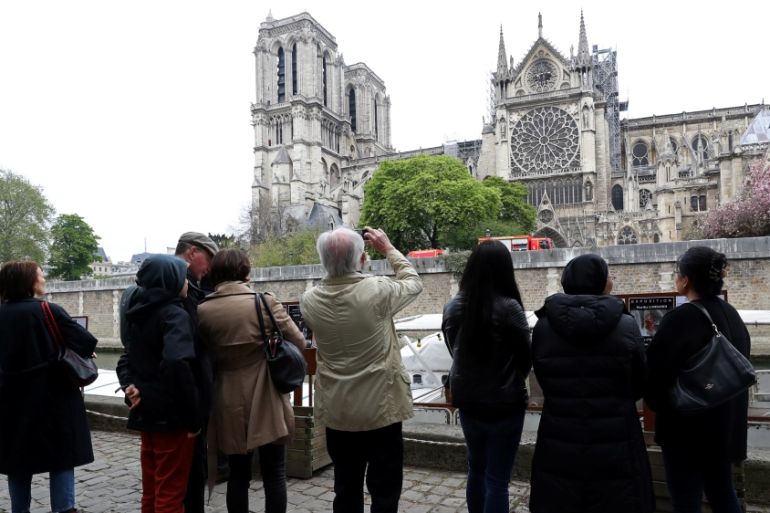Notre Dame and the case of misplaced empathy
Why is it that a Catholic cathedral in flames provokes more public grieving than the mass suffering and death of humans?

On 15 April, as news emerged of the fire raging at the iconic Notre Dame cathedral in Paris, social media was ablaze with hashtag-laden expressions of grief.
President Emmanuel Macron declared that the whole French nation was overwhelmed with “emotion”, while Paris mayor Anne Hidalgo could not find “strong enough words to express the pain” she felt.
Canadian Prime Minister Justin Trudeau and Mayor of London Sadiq Khan, among bazillions of others, tweeted that the incident was “heartbreaking”. US President Donald Trump called it “horrible” and offered the helpful suggestion that “perhaps flying water tankers could be used” to extinguish the flames.
Meanwhile, European Commission President Jean-Claude Juncker bewailed the “sad spectacle” and “the horror” of the fire at Notre Dame, an institution allegedly belonging to “the whole of humanity”.
Granted, humans on the receiving end of French colonial oppression or of the Catholic church’s long history of crimes might fail to detect a common cause.
International heartbreak
I’m not going to argue that it’s impermissible to lament the demise of historically and globally significant architecture – or that anyone shedding virtual tears on behalf of Notre Dame automatically doesn’t give a damn about other global causes.
But the magnitude of blaze-induced grief is nonetheless unsettling given that far more serious human tragedies rarely elicit such a level of international “heartbreak”.
Where are the calls for flying water tankers or the all-pervasive despair when, for example, Israel periodically undertakes to set the Gaza Strip on fire? During Israel’s 50-day Operation Protective Edge in 2014, the United Nations calculated that the Israeli military killed no fewer than 2,251 Palestinians, among them 299 women and 551 children.
Talk about loss and destruction.
The Israeli ambassador to the US valiantly defended Israel’s “right” to bomb hospitals – and yet the literal “horror” of this objectively “sad spectacle” hardly drew a mob of Twitter-mourners.
Ditto for the year-long killing and maiming spree unleashed by Israeli soldiers in 2018 onto peaceful protesters near the Gaza fence, which resulted in the death of more than 260 people and the injury of close to 30,000 others.
Nor has Yemen found itself to be especially heartbreaking on the international scene, despite being under continuous assault by a Saudi-led coalition. Though the country does attract split-second attention here and there – as when a US-supplied bomb slaughtered 40 Yemeni children on a school bus last year – there’s been no sustained collective weeping over reports that, since the start of the Saudi onslaught in 2015, 85,000 children may have died of starvation.
And there seemed to be hardly any reaction when, on April 7, the Saudi-led coalition bombed yet another school in Sanaa, killing 14 children, just days after British Foreign Secretary Jeremy Hunt published an op-ed in Politico arguing that the UK should not halt its export of weapons to Saudi Arabia.
A ‘higher purpose’?
To be sure, it’s pretty emotionally straightforward to grieve – in social media solidarity – over a Very Symbolic Building, one that has been firmly established in the international consciousness and visited by loads of fellow humans, particularly those belonging to social classes that possess the economic wherewithal to travel.
For US citizens like me, at least, it’s certainly easier than contemplating how to go about grieving Palestinians or Yemenis when my own government is highly implicated in their murder.
And while former US president Barack Obama somberly mused re: Notre Dame that “it’s in our nature to mourn when we see history lost”, it’s apparently not in our nature to mourn when we drop 26,171 bombs on the world in a single year – which is what Obama did in 2016 and which would seem to constitute a destruction of history in its own right.
Former Secretary of State Hillary Clinton, for her part, has also entered mourning mode with the following tweet: “My heart goes out to Paris. Notre Dame is a symbol of our ability as human beings to unite for a higher purpose.”
This is the same Clinton, of course, who once boasted of her willingness to “totally obliterate” the nation of Iran.
Raging empathy
The New York Times observes that the fire that tore through Notre Dame “generated an outpouring of grief in France and around the world as the symbol of French culture and history burned”.
As previously alluded to, however, French “history” has been none too inclusive, entailing instead blood-soaked colonial escapades founded on systematic torture and other forms of brutality.
Nowadays, Western colonial and imperial legacies continue to perniciously affect the livelihoods of much of the world’s population, and – what do you know? – refugees fleeing contexts of violence and poverty from Africa to Central America are often fatally blocked from joining that oh-so-cheery concept of “humanity”, as increasingly right-wing governments in Europe and the US endeavour to criminalise their very existence.
Hence the current heartless panorama, in which Guatemalan children die in US government custody and migrants drown by the hundreds in the Mediterranean.
Whatever your own attachment to Notre Dame might be, the fact that such tragic realities don’t elicit the same raging empathy as a cathedral fire is a tragedy unto itself.
The views expressed in this article are the author’s own and do not necessarily reflect Al Jazeera’s editorial stance.
